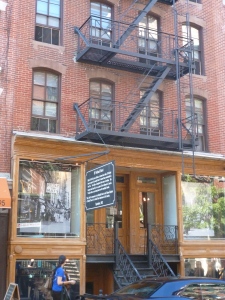New York City is home to many sites of interest to genealogists or anyone who appreciates and enjoys learning about our area’s past. Yesterday, I had the pleasure of visiting one of them, The Tenement Museum.
The Tenement Museum is a 5-story building at 97 Orchard Street in the Lower East Side, built in the 1860’s by German tailor and businessman Lucas Glockner. By the time the building ceased being used for residences in 1935, it had housed an estimated 7,000 individuals from more than 20 countries. I won’t get too much into the museum itself or the building’s history, as you can read that directly from their website.
Tours of the museum start at the bookstore/gift shop located at 103 Orchard, at the corner of Delancy. I strongly recommend purchasing tickets on-line in advance, as they do sell out and each tour is limited to about 12 participants.
There are several tours offered, focusing on different aspects of the immigrants’ experience, both inside the building and in the surrounding neighborhood. Most of the tours last one hour; one is 90 minutes. All require a good amount of walking. Special accommodations can be made if needed.
We took the “Irish Outsiders” tour. It started around the back of the building and went up to the fourth floor. It included two apartments that have been left in virtually the same state they were found in when the building was purchased in the late 1980s, after 50 years of neglect. It appears to be “authentic neglect” and not staged to look old. The other apartments have been restored to whatever time period being represented.
I have to say I was surprised that the apartment of the Moore family in 1870 was much nicer than what I expected it to be. The lower east side was certainly a step up from the Five Points, where the family previously lived and where they returned to several years later.
I was impressed that as part of the research into the building, they also located hundreds of descendants of former residents. Using records such as census and vital records, as well as personal recollections from the family members, the organization is able to present the stories of real people who lived here. Their efforts are to be applauded.
Three of the things I learned on our visit:
1. Catholic funeral customs include the covering of mirrors. I thought that was only a Jewish thing.
2. Building codes updated in 1901 required the installation of windows on interior walls to allow light to come in from the only exterior wall and to increase airflow between rooms. These “tuberculosis windows” didn’t work for preventing the spread of that disease.
3. There was a 10-day heat wave in 1896 that claimed the lives of 1500 New Yorkers. (That was from a book in the gift shop, not on the tour.)
I was somewhat disappointed that taking photographs is prohibited. I understand the need and can imagine that it would be distracting from the information being presented. They do hold a special photography event, which was last week. We’ll be sure to keep an eye for the next one.
Our tour guide, referred to as an educator, was extremely knowledgeable and very pleasant. They are not allowed to accept tips, so I made a contribution in the donation box instead. The wide selection of books covering every topic of New York history and immigration also makes it very easy to contribute to the cause! I wanted one of each.
I am looking forward to my next visit and already planning one for next month. If you have visited the museum, please comment; I’d love to hear what you thought of it!
Jodee


3 comments
Comments feed for this article
October 22, 2013 at 7:09 pm
one of the katherines
Jodee — this is awesome. Tricia wanted to hear about the visit, so I will send her your link.
October 23, 2013 at 12:45 pm
chmjr2
I got a kick out of the Moore family having a neat apartment. I guess I will do some dishes and try to uphold the family name. I enjoyed your post and put this on my list of must see when I go into New York City.
October 24, 2013 at 2:01 pm
Lorna
Great article Jodee. Thank you for sharing.